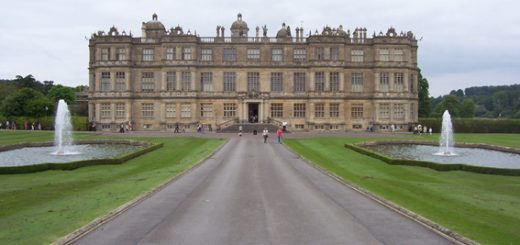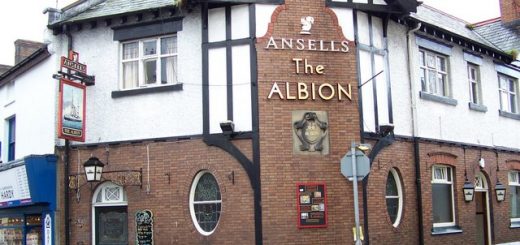The Elms, Smithfield
Smithfield haled a fairly prominent place in medieval London. Not only was it the site of a famous market and a place where Royalty held their tournaments, the Elms at Smithfield was also well known as a place of execution and it is thought that some of those who were cruelly killed at this spot may haunt it still. It has been suggested that sounds of screaming and the smell of burning has been experienced. Whether there is any substance to these experiences or not I cannot comment on and would love to hear from anyone who can elaborate on the supposed haunting here.
According to Old and New London: Volume 2 by Walter Thornbury (1878) ‘The chosen place for executions before Tyburn was the Elms, Smithfield, between “the horsepond and Turnmill brook,” (thought to be close to the church of Saint Bartholomew the Great) which, according to (John) Stow (Survey of London, 1598), began to be built on in the reign of Henry V. The gallows seems to have been removed to Tyburn about the reign of Henry IV. In Stow’s time none of the ancient elms remained.’ Smithfield and Tyburn were the usual locations in London used in the public executions of the lower classes, traitors and members of the upper class who were not very honoured. The upper classes who were usually held at the Tower of London were executed on Tower Hill on or in private behind the castles walls.
Certain types of execution were reserved for certain crimes. In England and Wales heresy (which basically meant your religious beliefs differed from the accepted Church) was punishable by being burned at the stake. High Treason was punishable by being hanged, drawn and quartered for men and burned at the stake for women. Petty Treason such as the murder by a woman of one of her superiors, for example her mistress or husband was also punishable by being burned at the stake.
14th Century
1305 – Sir William Wallace
 William Wallace the Scottish hero who fought for Scotland’s independence was executed at the Elms in Smithfield on St. Bartholomew’s Eve, 23 August 1305. He had been captured on 5 August 1305 after being betrayed by Sir John de Menteith at Robroyston. Taken to London and tried at Westminster Hall, he was found guilty of treason. He was taken from Westminster Hall, stripped and dragged naked by a horse to the place of his execution. Wallace was hung, drawn and quartered. Hanged till near death, they removed his genitals with a blunt blade, then cut him open so his intestines could be removed whilst he was still conscious. His bowels, heart and liver were burned and his head was then cut from his body. Wallace’s arms and legs were then removed. The head of William Wallace was preserved with tar and put on display for all to see on London Bridge. His limbs were sent north and seperatly put on display in Aberdeen (left quarter), Stirling (an arm), Newcastle upon Tyne and Berwick upon Tweed. Wallace never received a funeral, though it is thought that one arm was eventually buried in the grounds of Cambuskenneth Abbey. His left quarter was said to be entombed in the walls of St Machar’s Cathedral, Aberdeen.
William Wallace the Scottish hero who fought for Scotland’s independence was executed at the Elms in Smithfield on St. Bartholomew’s Eve, 23 August 1305. He had been captured on 5 August 1305 after being betrayed by Sir John de Menteith at Robroyston. Taken to London and tried at Westminster Hall, he was found guilty of treason. He was taken from Westminster Hall, stripped and dragged naked by a horse to the place of his execution. Wallace was hung, drawn and quartered. Hanged till near death, they removed his genitals with a blunt blade, then cut him open so his intestines could be removed whilst he was still conscious. His bowels, heart and liver were burned and his head was then cut from his body. Wallace’s arms and legs were then removed. The head of William Wallace was preserved with tar and put on display for all to see on London Bridge. His limbs were sent north and seperatly put on display in Aberdeen (left quarter), Stirling (an arm), Newcastle upon Tyne and Berwick upon Tweed. Wallace never received a funeral, though it is thought that one arm was eventually buried in the grounds of Cambuskenneth Abbey. His left quarter was said to be entombed in the walls of St Machar’s Cathedral, Aberdeen.
1330 – Roger de Mortimer, 3rd Baron Mortimer, 1st Earl of March
Mortimer was the lover of the Isabella of France, Queen of England and wife of King Edward II. Together they rebelled against Edward who was subsequently murdered in Berkeley Castle, Gloucestershire. The young King Edward III (born 13 November 1312 – died 21 June 1377) arrested Mortimer at Nottingham Castle for high treason. Convicted by a parliament at Westminster, Mortimer was drawn and hanged at the Elms at Smithfield on 29th November 1330. For two days his body was left hanging for all to see before being buried at Greyfriars. Isabella (She-wolf of France) was confined for the rest of her life in Castle Rising, Norfolk.
1381 – Wat Tyler
 Not strictly an execution, the rebel leader Wat Tyler met the young King Richard II at Smithfield before a 20,000 strong crowd. During the meeting between the leader of the revolt and the monarch, Sir William Walworth, Lord Mayor of London heard something he objected to and cut into Wat with his sword and he was finished off by John Cavendish.
Not strictly an execution, the rebel leader Wat Tyler met the young King Richard II at Smithfield before a 20,000 strong crowd. During the meeting between the leader of the revolt and the monarch, Sir William Walworth, Lord Mayor of London heard something he objected to and cut into Wat with his sword and he was finished off by John Cavendish.
15th Century
During 1401 King Henry IV signed the Statute of Heresy giving the clergy authority to arrest those that the bishop suspected of heresy. Those refusing to change their beliefs were burned at the stake. This was expanded upon by the 1414 Heresy Act allowing the church to call upon civil authorities to assist it and allowed courts of quarter sessions to receive heresy indictments and then to deliver the indicted persons to the church to be tried.
1401 – William Sawtrey
William Sawtrey a Roman Catholic priest was to fall foul of the 1401 Statute of Heresy. Sawtrey was a Lollard, a follower of John Wycliffe and rejected the Catholic Saints and the Eucharist in favour of a ‘Church of the Saved’. On 30th April 1399 Bishop Henry le Despenser took an interest in Sawtrey and he was imprisoned for about a month on charges of heresy. When he was released he renounced his Lollard beliefs. However, by early 1401 he was in St Osyth’s, London preaching Lollard teachings. He was brought before Archbishop Thomas Arundel in February 1401, charged with heresy, and convicted. He was burned at the stake at Smithfield in March 1401.
1441 – Margery Jordemaine (Gurdman or Jourdemaine or Jourdemayne)
Margery Jordemaine the ‘Witch of Eye’ was accused of using Witchcraft in an attempt to assassinate King Henry VI. She was implicated in this plot along with The Duchess of Gloucester, Thomas Southwell the Canon of St Stephens, John Hume and the astrologer Roger Bolingbroke. Found guilty of being a a witch and a heretic she was burned at the stake at Smithfield on 27 October 1441.
Other heretics burned at Smithfield in the 15th Century include John Badby in 1410 and Thomas Bagley, 1431.
16th Century
King Henry VIII ruled between 1509 – 1547 and in 1533 he repealed the 1401 Heresy Act, removing the Bishops right to arrest someone on suspicion of being a heretic. Henry however confirmed the 1414 Heresy Act therefore requiring that all heresy cases would have to start with a court indictment. This reduced the number of heresy prosecutions; however, during the reign of King Henry VIII, 81 people were executed throughout England and Wales for heresy.
The heretics killed by King Henry VIII at Smithfield included Richard Bayfield (1531), John Frith (1533), John Lambert (1538), John Forrest (1538), Richard Fetherston (1540) and Edward Powell (1540)
1546 – Anne Askew
 Anne Askew was a Protestant forced by her family into a turbulent marriage with Thomas Kyme who struggled to control her. She was arrested in London for distributing banned Protestant literature and giving sermons. Her husband returned her to their home in Lincolnshire though she soon escaped back to London. Anne has the dubious claim to being the only woman to have been tortured at the Tower of London prior to being burnt alive. Anne was racked and pressured to implicate others, possibly the Queen.. Her own account of the torture was smuggled from the Tower; “Then they did put me on the rack, because I confessed no ladies or gentlemen, to be of my opinion… the Lord Chancellor and Master Rich took pains to rack me with their own hands, till I was nearly dead. I fainted… and then they recovered me again. After that I sat two long hours arguing with the Lord Chancellor, upon the bare floor… With many flattering words, he tried to persuade me to leave my opinion… I said that I would rather die than break my faith”. On 16 July 1546, Anne Askew, then aged 25 was carried to Smithfield on a chair (as injuries suffered during the torture made her unable to walk). The stake also had an attached seat which she was tied astride of. She did not scream until the flames reached her chest, at which point a small bag of gunpowder around her neck exploded ending her ordeal.
Anne Askew was a Protestant forced by her family into a turbulent marriage with Thomas Kyme who struggled to control her. She was arrested in London for distributing banned Protestant literature and giving sermons. Her husband returned her to their home in Lincolnshire though she soon escaped back to London. Anne has the dubious claim to being the only woman to have been tortured at the Tower of London prior to being burnt alive. Anne was racked and pressured to implicate others, possibly the Queen.. Her own account of the torture was smuggled from the Tower; “Then they did put me on the rack, because I confessed no ladies or gentlemen, to be of my opinion… the Lord Chancellor and Master Rich took pains to rack me with their own hands, till I was nearly dead. I fainted… and then they recovered me again. After that I sat two long hours arguing with the Lord Chancellor, upon the bare floor… With many flattering words, he tried to persuade me to leave my opinion… I said that I would rather die than break my faith”. On 16 July 1546, Anne Askew, then aged 25 was carried to Smithfield on a chair (as injuries suffered during the torture made her unable to walk). The stake also had an attached seat which she was tied astride of. She did not scream until the flames reached her chest, at which point a small bag of gunpowder around her neck exploded ending her ordeal.
King Edward VI (1546 – 1553) only executed two people on charges of heresy, a very low number compared to the other early Tudor monarchs.
1550 – Joan Bocher (Boucher, Butcher or Knell, Knel)
An associate of Anne Askew Joan Bocher or Joan of Kent was an anabaptist, an unpopular belief amongst both Protestants and Catholics. In the 1540’s she would smuggle copies of William Tyndale’s New Testament into the Royal Court and distribute them amongst the ladies there. Originally arrested in 1543 she was again arrested in 1548. She was found guilty of heresy in April 1549 and burned at the stake at the Elms, Smithfield on 2 May 1550.
Edward was succeeded by his Catholic older sister Queen Mary I who ruled between 19 July 1553 and 17 November 1558. Mary wanted to bring her kingdom back to the Catholic faith and Protestants were forced to convert, forced into exile or face punishment which included being burned alive. During the subsequent Marian Persecutions hundreds of Protestants were executed, sometimes burning families units together. The number of Protestants she had burned alive is somewhere between 254 and 280 (this is the national total, not Smithfield executions), with other prisoners dying in incarceration before they could be executed. This is why she is known as Bloody Mary.
Amongst the heretics burned at Smithfield by Mary are John Bradford, John Cardmaker, John Philpot, John Warne, John Rogers (4th February) in 1555 and John Rough in 1557.
1557 – John Hallingdale, William Sparrow, and Master Gibson
The death of these three Protestants was described by John Foxe in his Book of Martyrs (1563). “And so these three godly men, John Hallingdale, William Sparrow, and Master Gibson, being thus appointed to the slaughter, were, the twelfth day after their condemnation (which was the 18th day of the said month of November, 1557), burnt in Smithfield in London. And being brought thither to the stake, after their prayer made, they were bound thereunto with chains, and wood set unto them; and after wood, fire, in the which being compassed about, and the fiery flames consuming their flesh, at the last they yielded gloriously and joyfully their souls and lives into the holy hands of the Lord, to whose tuition and government I commend thee, good reader. Amen.”
1558 – Roger Holland
Roger Holland was another of the Protestants killed for heresy during the reign of Queen May I. John Foxe in his Book of Martyrs (1563) describes Rogers death. “The day they suffered a proclamation was made that none should be so bold to speak or talk any word unto them, or receive anything of them, or to touch them upon pain of imprisonment, without either bail or mainprize; with divers other cruel threatening words, contained in the same proclamation. Notwithstanding the people cried out, desiring God to strengthen them; and they, likewise, still prayed for the people, and the restoring of His word. At length Roger, embracing the stake and the reeds, said these words:— ‘Lord, I most humbly thank Thy Majesty that Thou hast called me from the state of death unto the light of Thy heavenly word, and now unto the fellowship of Thy saints, that I may sing and say, Holy, holy, holy, Lord God of hosts! And Lord, into Thy hands I commit my spirit. Lord, bless these Thy people, and save them from idolatry.’ And so he ended his life, looking up into heaven, praying and praising God, with the rest of his fellowsaints: for whose joyful constancy the Lord be praised.” Roger was burned alongside seven other Protestants.
17th Century
Hangings at Smithfield included the Highwayman James Whitney on 19th December 1694.
18th Century
Amongst those who died at Smithfield in the17th Century was John Perrott who was a bankrupt that refused to fully disclose his effects.
Burning people at the stake or dragging convicts through the streets before hanging and gutting them was not the most efficient way to execute these prisoners, it done in this manner to make a point, to teach the crowds of people watching that if you commit treason or follow a heretical view point, then you will be killed in the most horrific manner possible. We should also consider that the heretics were not evil doers, they were just Christians who interpreted the bible differently and had a slightly different way of worshipping. In this day and age when we have different Christian churches to choose from and the freedom to believe in whatever we want to believe, it is hard to accept that 500 years ago, in the heart of London, people were burned alive in public spectacles by fellow Christians. It is sometimes easy to forget that people have died for most of the freedoms we take for granted.




Recent Comments